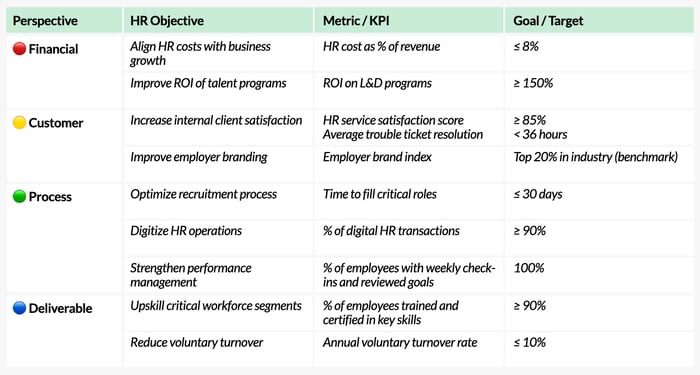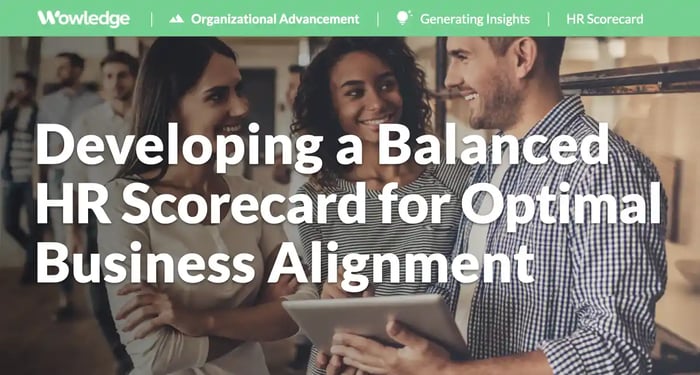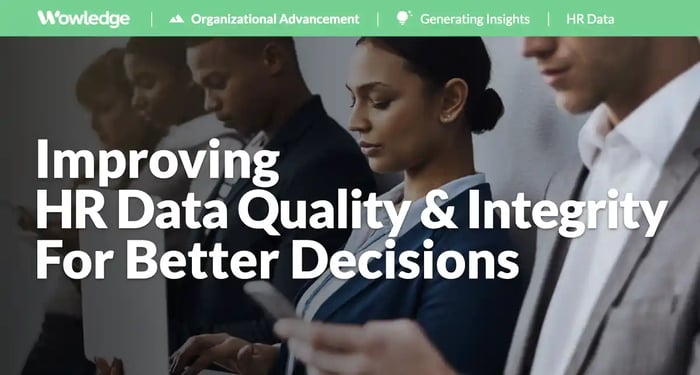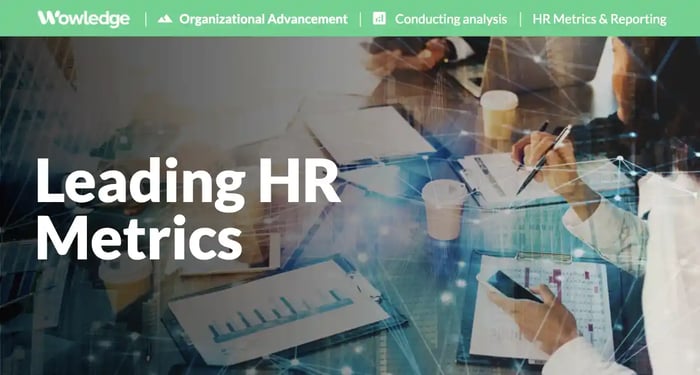Table of Contents
- The balanced HR scorecard
- The purpose and value of a balanced HR scorecard
- How a balanced HR scorecard differs from HR reports and HR dashboards
- Key elements and attributes of a balanced HR Scorecard process
- The benefits of implementing an HR scorecard
- Building a balanced HR scorecard
- Relevant Practices & Tools
- About Wowledge
Among the many growth opportunities for HR teams, perhaps the most crucial is aligning their efforts with business objectives. Creating a responsive HR strategy is only a starting point, as the function's ability to follow through with mechanisms for prioritizing, tracking, and managing its efforts differentiates the level of business impact it can achieve. That can be achieved through the development and deployment of a balanced HR scorecard that establishes how HR supports business direction and success.
The balanced scorecard was developed in the early 1990’s by Robert Kaplan and David Norton as a framework for better assessing corporate success and projecting it into the future. It was designed to evaluate enterprise performance on more than traditional financial measures alone, expanding the definition of success to include (and thus “balance”) talent, customer, process, and economic excellence. These four performance elements are linked together in a value chain(s) that look forward into the future to expand the use of lagging indicators (financial) with those that drive future, longer-term success (customer, process, people).
The balanced HR scorecard
Applied for use by HR teams, the (Balanced) HR Scorecard was introduced in 2001 by Becker, Huselid, and Ulrich as a way to articulate and prioritize performance on the HR processes, policies, programs, and platforms that link to the business. It represents what we now consider data-driven or analytically based HR, and informs evidence-based HR (EBHR) approaches. It involves a comprehensive analysis of HR-related performance and contributions that consider all the attributes that any leader is required to balance and deliver on – financial, customer, process, and workforce objectives that define success. It is used for decision support and, at its most potent and meaningful, focuses on the ways that people (individual and managerial) and HR processes and activities impact business outcomes.
The purpose and value of a balanced HR scorecard
The scorecard represents the outcome of a multi-step approach that is designed to:
- Communicate the value of key HR processes, practices, and programs and specify the business objective they are expected to impact
- Prioritize projects, products, and services that drive and support the achievement of business and operational goals
- Align the day-to-day work of HR teams with enterprise strategies
- Measure and monitor progress and HR’s contributions to strategic targets
The scorecard provides meaning to the work of HR teams, as it helps generate understandable linkages between the business’s mission and strategic plans with the ongoing management of people processes, projects, and programs. It creates clarity as to the relative importance of (and ability to impact) the organization’s most important financial, operational, customer, and talent outcomes. The scorecard provides a framework for evaluating the effectiveness of HR functions and their impact on business outcomes.
How a balanced HR scorecard differs from HR reports and HR dashboards
Three main concepts of HR analytics differ in their purpose, formatting, and delivery—the HR report, dashboard, and balanced scorecard. They are created for what may appear to be overlapping purposes, but each has unique benefits and target audiences.
The most basic of these is the HR report, which is a detailed, yet relatively static, presentation of tables and charts related to standard HR process metrics, primarily designed for use by the HR team, such as new hire volume, turnover, training hours per employee, merit increase pool distribution, and performance evaluation completions. Many of these evaluate and communicate the efficiencies and compliance rates of employees and line managers in HR processes. They tend to offer lagging data that provides a look-back over the prior week, month, or quarter.
An HR dashboard is designed to present a real-time visualization of critical people management metrics that can be reviewed, analyzed for performance outliers, and root causes (e.g., with drill-down and time-trending capabilities). It utilizes graphs, charts, and maps to present data that can be quickly scanned and understood. The dashboard offers more sophisticated analytics that combine lagging (lookback) and leading (predictive) analytics, including advanced statistical tests that reveal relationships, trends, and issues between and within business and talent activities and results. It is designed to provide timely insights, enabling immediate adjustments and improvements to emerging problems and barriers to success.
The balanced HR scorecard is a strategic tool that measures and tracks HR’s contributions to achieving specified business goals. It is designed for longer-term strategic HR performance monitoring, with clear links between the HR infrastructure and business outcomes. It relies upon a smaller and more select set of metrics that have been demonstrated to have a measurable impact on targeted goals. The scorecard is designed to communicate what is most important to the HR team (and its sub-teams), the key performance indicators (KPIs) that track their performance, and how these relate to specific business goals and strategic directions.
Balanced HR Scorecard Template Sample
Key elements and attributes of a balanced HR Scorecard process
Strategic business alignment
The main purpose of HR scorecards is to establish direct and measurable links to overall business strategy and objectives. The mapping of HR processes, practices, and programs to specific business objectives (capacity, process, customer, and financial) generates a clear and concise value chain.
Key performance indicators (KPIs)
These identify and track key performance indicators relevant to both HR and the business, enabling the measurement of HR's impact. The use of KPIs in balanced scorecards highlights an important difference with OKRs (objectives and key results), as those focus HR teams on their business contributions via aggressive, shorter-term goals, whereas KPIs in scorecards combine to target broader and longer-term organizational objectives.
Integrated business and talent metrics
The scorecard incorporates business metrics (financial, operational, production, customer) metrics with the talent metrics that are demonstrated to contribute to the critical business outcomes.
"Balanced" view
It provides a comprehensive view of HR performance by going beyond financial measurement as the definition of success to considering a more comprehensive set of enablers, drivers, and elements of business achievement, including customer, internal processes, and organizational learning and growth.
Stakeholder Involvement
Engages business and functional stakeholders in the development and ongoing evaluation of the scorecard to generate awareness of HR’s objective ability to contribute, the manner in which its processes and programs impact desired outcomes, and the extent to which those contributions are meeting their targets to generate buy-in and alignment.
Continuous improvement
The scorecard is designed to identify areas where HR can improve its processes and strategies to more effectively drive and support the achievement of business objectives.
The benefits of implementing an HR scorecard
Adopting a balanced HR scorecard approach provides unique opportunities to build on quality strategic planning and analytic practices by identifying and tracking specific linkages between HR processes, policies, and programs and critical business objectives. It generates focus for all HR leaders and their teams on how, when, and where their efforts can best support the business. The primary advantages include:
- Demonstrates impact. It helps demonstrate the return on investment (ROI) of HR processes and initiatives and the specific value that the function adds to the organization’s goals and objectives. A balanced HR scorecard creates a common language and basis for business and HR leaders to review, analyze, and seek enhancements to shared objectives.
- Improves alignment. It reveals the value chain between HR activities and the overall business strategy, fostering a more objective, cohesive, and integrated approach between HR teams and the operations they jointly support.
- Supports strategic prioritization. Balanced HR scorecards support improved prioritization of plans and the allocation and deployment of resources. Particularly when HR budgets, investments, and staffing are constrained, these help align HR priorities towards those that most impact company strategies.
- Drives better decision-making. The reliance on a range of metrics (business and HR or talent) and associated analytics provides data-driven insights to inform HR strategies, track progress, and support more objective decisions. It helps identify talent gaps and areas where HR needs to focus its efforts to build a high-performing workforce.
- Provides meaning and context. Using a scorecard supports communication of how HR employees' work efforts, at every level of the organization, contribute to specified business objectives. Armed with this understanding, they can take greater pride in their contributions to business success and the achievement of targeted outcomes. It further provides context to managers and employees by communicating the linkage between HR activities and those of the business.
- Increases accountability. These enable the HR team and its members to track their prioritized objectives and use more fact-based and data-driven means to hold them accountable for their performance and goal achievement.
The value proposition for HR is substantial, going beyond business alignment and prioritization. When developed in a disciplined and data-driven manner, it enhances the image and perceptions of the function. It has the potential to shift the all-too-common views of HR as the “people function” that relies upon emotion, mushy, subjective, and intangible rationale for its processes, practices, and programs. It supports the creation of a more compelling business narrative as an influential function that is recognized as a key contributor to operational, market, and financial success. It enhances the reputation through clear, objective lines of impact by differentiating between the administratively and legally required processes and those that strategically impact desired operational and business outcomes.
It can be used to emphasize the importance of (and HR’s ability to drive) improved employee productivity, managerial behavior and performance, high performer motivation and retention, targeted employee skill development, collaboration, innovation, and customer focus.

Building a balanced HR scorecard
The establishment and design of a balanced HR scorecard is a strategic exercise that, at its best, involves leaders from across an HR team representing the CHRO, HRBPs, process owners (e.g., COEs), Analytics, and execution teams (e.g., HR Shared Services) along with business and functional leaders. Including experts from Finance, technology, operations, and business units helps ensure alignment and agreement about how various HR processes, programs, practices, and technologies influence or drive specific business objectives.
The exercise requires data and analyses that support the proposed/theorized relationships between HR activities and business results. Those are ideally developed before the exercise begins, but organizations with fewer resources may choose to conduct those afterwards as a validation and refinement phase. In either case, a planned and scheduled effort should be conducted at least annually to review and test the assumptions that went into determining the relationships. The steps include:
1. Identify strategic business objectives and goals
Draw the strategic objectives and business priorities from a review of the most recent organizational mission statement, strategic plan, and multi-year or annual goals. Do the same for the business units, as those will need to be referenced during the goal cascading phase. Consider mission or strategic positioning statements such as “Create the best customer experience in the industry”. Those serve as targets for business operations that HR should mirror as it considers how its offerings support the mission of the organization.
Next, look for specific and measurable objectives and goals, such as “acquire and retain high-value customers who buy higher profit services or products in greater volumes in a repeated or continuous fashion”, “reduce cost per unit”, or “drive product reliability and quality to Six Sigma levels.” These offer insights into the analysis and targeting of HR’s ability to impact sales, profitability, and production.
2. Define HR deliverables
This is a crucial step that clarifies the value HR delivers from the perspectives of its stakeholders – leaders, managers, and employees. It separates deliverables (what HR’s internal customer needs) from “enablers” (the processes and activities that support or surround those). Consider the employee experience (EX), which is a process (and outcome) that focuses on what employees need and prefer to make their work lives easier to navigate.
From a balanced HR scorecard perspective, consider examples of these from recruiting (“a sufficient volume of qualified candidates in a timely manner”), leadership development (“continuously growing and prepared leaders and HiPos against future skill requirements”), and succession management (“a sufficient number of ready-now candidates from which to select for all leadership roles”).
3. Create a strategy map
A strategy map defines the value chain from HR’s offerings to business results. Leading practice calls for statistical analyses of the relationship between HR processes and activities and business results, but this is often based upon educated hypotheses that can be later tested with analytics. Either way, the process involves identifying the value chain in four progressive steps:
| Key Question Step | Example of Outcome |
| How does each HR function’s critical talent outcome... | Quality of Hire (Recruiting) |
| Influence internal or business processes (product or service quality)... | Cycle time |
| Which in turn influences customer or supplier outcomes... | Satisfaction |
| Which impacts the level of financial returns yielded (ROI). | Profit |
4. Develop strategic measures
The key to a solid, balanced HR scorecard is the metrics that are selected to set HR performance goals, track progress, and identify opportunities for continuous improvement. These include a combination of lagging (looking back) and leading (predictive) value creation measures that reflect how HR processes and activities impact each business outcome. Two types of measures (with examples) can be used to measure the impact.
- Talent effectiveness. Employee engagement, turnover, net promoter score (NPS), critical skill or top performer, and new hire retention, mobility, quality of hire (QoH), strategic skill gaps and shortages, time to competency, employee well-being (stress), succession candidates’ selection rate, collaboration, and teamwork.
- Talent efficiency. Hires vs. openings, replacement latency rate, cost per hire, learning activity alignment (with task performance and verified skill adoption), learning activity recommendation ratings, self-service utilization rate (use by role, escalations)
Statistical analysis is used for leading or predictive measures, and relies upon regressions to identify and demonstrate the extent to which HR processes, programs, and platforms impact (alone or in combination) the primary business outcomes. This should be performed for every major HR process area.
5. Set goals
Developing targets for each HR measure commonly relies upon benchmarking against industry performance standards or historical internal performance. These are developed based upon how much improvement is considered achievable or a quantitative (e.g., statistically modeled) estimate of what improvement makes sense. For example, a 10% reduction in training costs will yield X savings per year, or a 12% decrease in application process time will generate Y more offers accepted.
6. Document the strategy map and scorecard
Develop the map and scorecard in a visually appealing manner to create an easily scanned and understood platform for communication to business and HR stakeholders alike. The strategy map should flow (from bottom to top) the perspectives (Deliverable, Process, Customer, Financial), and then across the page from each, columns for the associated HR or talent objective, the measure or metric, and the goal or target. In this way, a single scorecard can be used to display the relationship between HR and business objectives along with the relevant measures.
7. Communicate and cascade goals
The completed scorecard should be shared with business leaders and the HR team members to establish a common understanding of the value HR delivers, and its plans to prioritize and execute against the standards set. The goals should be cascaded downward throughout the HR team, with each successive level of the team and employees developing goals that will support and drive toward those objectives. Regular posting and discussion of results should follow, ideally on a schedule that can be relied upon, such as quarterly.
Relevant Practices & Tools
Core HR Strategy Practices to Define a Foundational Direction for the HR Function. >
An HR Strategy sets business-based human resource (HR) tactics that will constitute a comprehensive multi-year approach to managing the HR function's structure, governance, programs, policies, and practices... more »
Deploying Advanced Statistical Methods to Better Assess and Predict Trends in HR Processes, Policies, and Programs. >
Deploying advanced methods involves moving from descriptive or basic mathematical metrics to more sophisticated techniques that provide more meaningful analyses and reveal relationships or predictions between processes, programs, behaviors, and their outcomes... more »
Cascading and Updating Strategic Goals that are Aligned with Organizational Objectives. >
Creating a formal flow of goals from top executives down to the lowest level employees ensures an alignment of work efforts and objectives from the top to the bottom of the organization... more »
Benchmarking to Compare with External (Professional, Industry, Regional) Standards. >
Comparing data from one company to similar companies provides context when reviewing company data... more »
The Process to Outcomes Translation Tool: Convert HR Strategies and Processes into Representative Metrics. >
The Process to Outcomes Translation tool is designed as a guide to creating metrics that represent HR's impact on the business... more »
About Wowledge
Wowledge is the implementation-first platform designed for lean HR teams and consultants who need to design and scale strategic HR programs efficiently—without starting from scratch.
Our members gain access to continuously updated best practices, step-by-step guidance, expert-built tools, and customizable templates—all structured to accelerate the development and implementation of key HR programs.
Recognizing that every organization operates at different levels of sophistication, Wowledge’s scalable system of best practices follows a stage-based approach—Core, Advanced, and Emerging—ensuring HR professionals can implement solutions tailored to their organization’s unique needs and goals.
Your Shortcut to Amplifying HR Impact!
Get started for FREE! Learn more.










